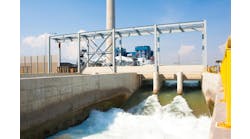Engineers at Brown University, Providence, R.I., have developed a wastewater treatment system that significantly reduces the concentration of heavy metals without producing the toxic byproduct sludge created using traditional methods. Treatment gives decontaminated water and solid particles containing the metals the option to be disposed of or processed for metal recovery. The system is said to be ideal for wastewater remediation and other metal recovery applications.
Tests show it can effectively remove low concentrations of copper, nickel and cadmium simultaneously, upgrading contaminated water to near or below federally accepted contamination levels. In trials, cadmium, copper and nickel concentrations fell to 1.50, 0.23 and 0.37 ppm, respectively.
The so-called cyclic electrowinning/precipitation (CEP) system can remove up to 99% of copper, cadmium and nickel, say its developers — Joseph Calo, professor emeritus of engineering at Brown, postdoctoral researcher Pengpeng Grimshaw, and George Hradil, a senior research engineer at Cranston, R.I.-based Technic, Inc. The automated system combines two proven removal techniques but eliminates the disadvantages each typically poses.
Electrowinning removes heavy metals in an aqueous solution in an electrolytic cell by depositing them on a cathode, but usually requires relatively high current when the metals are at low concentrations. Precipitation uses hydroxides and sulfides to precipitate metal ions from the water, creating a toxic sludge byproduct.
"Instead of getting rid of [the sludge byproduct], we keep it in the process, redissolve it and use it… to increase the metal concentration to the point where… you take it out with electrowinning. So that's the whole idea — to use the positive aspects of each of those techniques in tandem so that you can try to minimize the undesirable aspects of each," says Calo.
The CEP system relies on multiple precipitation cycles to boost metal ion concentration in the water to a level at which electrowinning to plate out the metals can take place at good current efficiencies. Water analysis determines the number of precipitation cycles needed. The electrowinning cell uses a device developed by Hradil called a spouted particulate electrode (SPE) that allows operation at higher current densities and efficiencies. The water then undergoes another precipitation as a finishing step. If necessary, water can pass through other refining steps to further increase its purity level.
"For an initial 10-ppm ion concentration of the metals considered, the volume reduction is on the order of 106," say the researchers. Moreover, the system does away with the need for sludge disposal.
An article in Chemical Engineering Journal describes the system in more detail.
Key challenges remain. The researchers haven't been able to duplicate every conceivable metal contaminant, notes Calo, who adds that very fine solids likely could interfere with electro-deposition.
Further testing of other metals will take at least another year, but Calo stresses that the automated CEP system is ready for scale-up.
"Scaling up isn't a huge problem. Right now, it's basically a general device. In order to evaluate the economics of the process you have to have a very specific application because every source of waste is different — wastewater, sediment — it depends on what's in the water, at what concentration — a million different things," he says.

